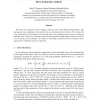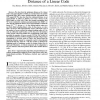76 search results - page 2 / 16 » Random codes: Minimum distances and error exponents |
CORR
2008
Springer
13 years 5 months ago
2008
Springer
An erasure channel with a fixed alphabet size q, where q 1, is studied . It is proved that over any erasure channel (with or without memory), Maximum Distance Separable (MDS) codes...
TIT
2010
13 years 5 days ago
2010
Typical minimum distances and error exponents are analyzed on the 8-PSK Gaussian channel for two capacityachieving code ensembles with different algebraic structure. It is proved t...
CORR
2010
Springer
13 years 2 months ago
2010
Springer
A unified framework to obtain all known lower bounds (random coding, typical random coding and expurgated bound) on the reliability function of a point-to-point discrete memoryles...
DCC
2006
IEEE
14 years 5 months ago
2006
IEEE
We discuss two approaches for decoding at arbitrary rates in the Slepian-Wolf problem - time sharing and source splitting - both of which rely on constituent vertex decoders. We c...
FOCS
1999
IEEE
13 years 9 months ago
1999
IEEE
We show that the minimum distance of a linear code is not approximable to within any constant factor in random polynomial time (RP), unless nondeterministic polynomial time (NP) eq...


